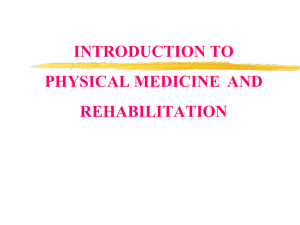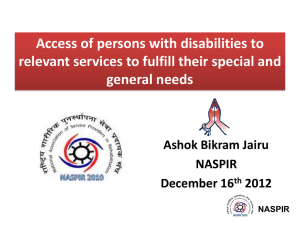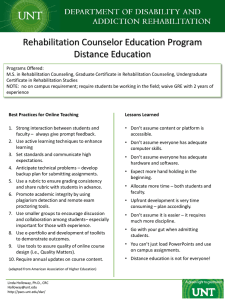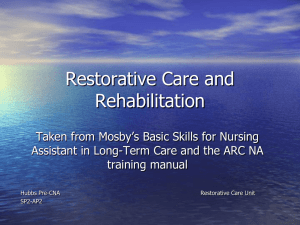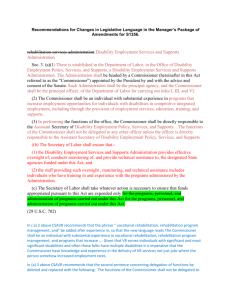Introduction to CERT - Burton Blatt Institute at Syracuse University
advertisement
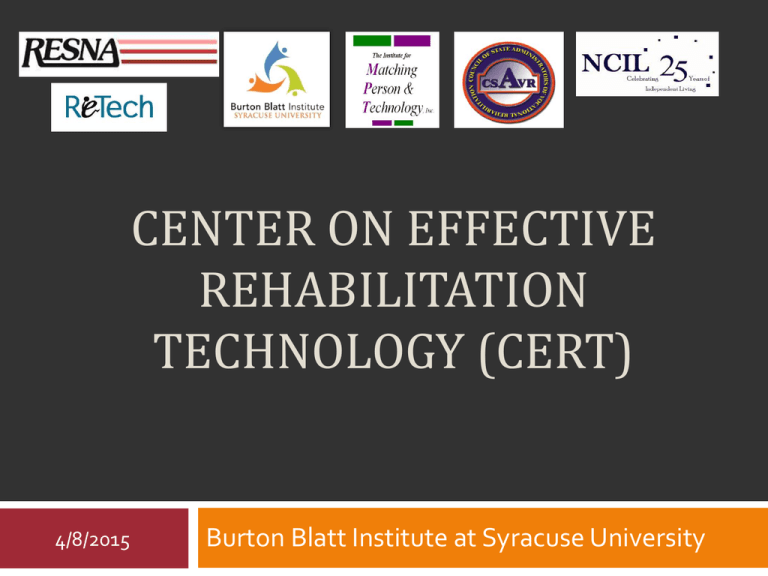
CENTER ON EFFECTIVE REHABILITATION TECHNOLOGY (CERT) 4/8/2015 Burton Blatt Institute at Syracuse University Project Partners 2 The Burton Blatt Institute (BBI) at Syracuse University and the Institute for Matching Person and Technology (IMPT) In collaboration with the Council of State Administrators of Vocational Rehabilitation (CSAVR) Rehabilitation Engineering and Assistive Technology Society of North America (RESNA) National Council for Independent Living (NCIL) Rehabilitation Technology Associates, Inc. Definition of Rehabilitation Technology 3 Systematic application of technologies, engineering methodologies, or scientific principles to meet the needs of, and address barriers confronted by, individuals with disabilities in areas including education, rehabilitation, employment, transportation, independent living, and recreation. The term includes rehabilitation engineering, assistive technology devices, and assistive technology services (29 U.S.C. §705(30), 2000) Goal One 4 Conduct research to identify, document, and analyze models of effective rehabilitation technology service delivery to assist individuals with disabilities achieve employment outcomes Development of Quality Indicators Selection of State VR agencies and RT Support Units (6), State AT Programs and CILs (3), Employers based programs (3) for indepth study 12 case studies (Qualitative + Quantitative) Cost-Benefits of RT Service Delivery Goal Two 5 Identify, test, and develop strategies to support the VR counselor to make informed and effective decisions in concert with individual with disabilities to select the most appropriate RT Develop new prototype measure for effective RT assessment and decision-making Interactive Training Program to build skills to use new tool and measures Validate tool and training program Goal Three 6 Translate research findings to policy development and practice through a comprehensive menu of knowledge dissemination activities that accelerates and supports change at an individual and systems level Model policy and procedures Quality indicators self-assessment checklist Center website RT Accommodations Database Target Audiences 7 State VR Agency Directors and Senior Management State VR Agency Service Units VR Counselors Employment and Training Programs Employers and Human Resource Professionals Persons with Disabilities and Families including Centers for Independent Living Employment Networks and the Workforce Investment One-Stop Career Centers Policymakers at National, State and Local Levels Rehabilitation Educators Researchers from Multiple Disciplines AT Practitioners, Manufacturers and Suppliers Media (General and Targeted) Lead Staff 8 1. 2. 3. Peter Blanck (J.D., Ph.D.) – Principal Investigator Expert on Employer Practices Quantitative and Qualitative Research Methods Marcia Scherer (Ph.D., M.S.) – Co-PI Expert on AT Assessment and Use Quantitative and Qualitative Research Methods Michael Morris (J.D.) – Co-PI Expert on AT Financing and Policy Development at a Systems Level Knowledge Translation Activities Deepti Samant, M.S. (Rehab), M.S. (ECE) – Project Director 4. Expert on Employer Practices, Accommodations, Accessible Technology Grant Leader / Project Director Core Staff 9 Meera Adya, J.D., Ph.D. – BBI Steven Mendelsohn, J.D. – BBI Lacy Pittman, Policy Analyst - NCIL Anjali Weber, M.S. (Biomedicial Engineer) – RESNA Jurgen Babirad, M.S. (Rehab) – ReTech Margaret Glenn, Ph.D. (Counseling) – CSAVR Kathy West-Evans, MPA – CSAVR Blue Ribbon Advisory Panel 10 Brian McLane, Burton Blatt Institute (CHAIR) Nell Bailey, RESNA Kelly Buckland, NCIL Beth Butler, Wachovia, a division of Wells Fargo Berthy De La Rosa-Aponte, Former Chair, Ticket to Work Advisory Panel Tom Foley, World Institute on Disability Dennis Gilbride, Rehabilitation Counseling and Human Services, Syracuse University Glenn Hedman, AT Unit, Dept. of Disability & Human Development, UIC Robert Kilbury, Illinois VR Agency Director Blue Ribbon Advisory Panel 11 10. Tammy Koger, North Carolina AT Program 11. John Lancaster, Individual capacity 12. Karen Milchus, RERC on Workplace Accommodations, GA Tech 13. Kevin Nickerson, Disability Program Navigator / CWIC, Tompkins Workforce, New York 14. Jeff Rosen, Agilent Technologies 15. Deb Russell, Walgreens Corporation 16. Carl Suter, CSAVR 12 RESEARCH PROJECTS 13 Goal I IDENTIFY, DOCUMENT, AND EVALUATE REHABILITATION TECHNOLOGY SERVICE DELIVERY MODELS (VR-Based, Employer-Based, and Consumer-Identified Alternative Models) Overview of Goal 1 Activities 14 Survey VR RT Support Units Survey SILCs & ILCs Survey State AT Act Programs Survey Blue Ribbon Panel Surveys will identify current practices, identify strong VR-based programs, identify alternative programs to VR or Employers, identify quality indicators of success from which benchmarks will be constructed to evaluate programs selected for case studies. Use information gathered from surveys above & RSA-911 data to identify 6 VR-based programs for case studies. Consult with NIDRR on selection of sample. Use information gathered from surveys above and contacts through project partners to select 3 employer organizations for case studies. Adapt DOL & WorkRERC surveys as needed. Use information gathered from surveys above to select 3 consumer-identified, alternative models to VR & Employer-based programs. 15 Research Project I AT/ RT Service Delivery: The Vocational Rehabilitation System and Non-Employer Based Alternative Models Proposed Activities 16 Activity A - Survey of all State VR RT Support Units Activity B - Blue Ribbon Panel review & evaluation Obtain baseline of services, systems, policies, practices, and outcomes Develop a comprehensive list of possible quality indicators Activity C - Survey of ILCs and State AT programs Identification of effective VR managed and non-VR models of service delivery Activities Continued 17 Activity D - Analysis of existing datasets e.g. RSA911 Identify which VR managed programs demonstrate success in providing AT/RT for successful employment, findings combined with surveys results from VR RT Units, State AT Programs, ILCs Blue Ribbon Panel will assist in developing selection criteria and short-listing programs for in-depth studies Selection will be sent to NIDRR, which will approve final sample Activities Continued 18 Activity E – Case Studies on Selected VR & Alternative Programs In-depth structured case study methods (interviews, surveys, focus groups, analysis of case records and other data) to understand and evaluate the selected model programs 6 VR-Based Programs – 4 “mainstream,” 2 programs for People with Visual Disability 3 alternative programs identified through SILC and ILC surveys Sample will include: Current and Past VR Clients, VR Counselors (VRCs), AT/RT practitioners, and Employers working with VR 19 Research Project II AT/RT Provision and Support in the Workplace: Employer Models and Their Effectiveness Proposed Activities 20 Corporate Culture & Disability Employment Through Effective Accommodations Based on BBI’s ongoing research on the employment of persons with disabilities, corporate leadership in disability employment, and workplace accommodations Case Studies of 3 Employer-Based Programs Focus groups and in-depth interviews with employees with disabilities, managers and supervisors; a company-wide employee survey; collection and analysis of written policies relating to disability and diversity (archival analysis); and collection and analysis of available administrative data on disability accommodations and initiatives Proposed Activities 21 Workplace Accommodations: Cost-Benefits & Effectiveness Over the Long-term Development of an evidence-based framework for understanding the cost-benefit analysis of the value of workplace accommodations, including on AT/RT access and use. Workplace Accommodations: Cost-Benefits & Effectiveness Over the Long-term Three waves of surveys, over 5 years with the same sample being tracked longitudinally 22 Goal II RESEARCH PROJECT 3: ASSESSING REHABILITATION TECHNOLOGY SELECTION AND USE Proposed Activities 23 Develop a new prototype measure specific to devices used to enhance job skills and employment Develop prototype computerized scoring, interpretations for new measure Develop a pre- and in-service prototype interactive training program Proposed Activities 24 Test the new measure, scoring and interpretations, interactive training program Validate the effectiveness of the new measure, scoring and interpretations, interactive training program and assess impact Proposed Activities 25 National experts will rate the importance of 75 items generated by research staff for new measure Measuring usability of products by end-users Two-group, true experimental design with 40 VRCs Information gathered from AT/RT consumers Dissemination Activities 26 Center Website E-Newsletter Conference Presentations Distance Learning Leadership Series Communities of Practice Policy and Program Briefs Publications DBTACs and TACE Policy Roundtable Materials Development 27 Quality a) b) c) Accessibility a) Usability Sensitivity Accuracy Alternative formats Customer Satisfaction a) b) Relevance Impact Project Outputs (Research) 28 1. 2. 3. 4. 5. Development of a model policies and procedures template for “effective service delivery”. Development of a quality indicators self-assessment check list for VR and non-VR managed programs. In-depth case studies of VR (6) and non-VR AT (3) service delivery programs. In-depth case studies of 3 employer-based AT service delivery programs. A report that compares & contrasts quality indicators from 12 selected programs of AT delivery service. Project Outputs (Research) 29 6. 7. 8. 9. Development of a new RT assessment tool and measures designed to create a better match for consumers and technology solutions to advance employment outcomes. Development of a new data collection instrument to help improve measurement of AT cost-benefits. A longitudinal cost-benefits analysis of AT service delivery. Establishment of an RT accommodations database. Project Outputs (Knowledge Translation) 30 1. 2. 3. 4. 5. Development of the website to serve as a dissemination hub. Initiation of on-site & distance learning opportunities with CSAVR, NCIL & RESNA to reach all audiences. Research articles, informational briefs, journal, newsletters, & mainstream media articles. Establishment of communities of practice & an enewsletter to reach all audiences. Initiation of a policy roundtable in Washington, DC. Project Outcomes 31 1. 2. 3. 4. 5. New knowledge among target audiences of the systematic supports needed for effective RT service delivery. Changes at state and local levels through replications of effective polices and practices. Use of new methods to collect and analyze data on the impact of RT on employment outcomes. Improved sustainable collaborations among key stakeholders: VR professionals, AT practitioners, employers and persons with disabilities. Improved informed decision-making between the VR counselor and the individual with a disability to better match AT with individuals needs and preferences. Funding 32 CERT is funded by a grant from the U.S. Department of Education, National Institute on Disability and Rehabilitation Research (NIDRR), for the “Center on Effective Delivery of Rehabilitation Technology by Vocational Rehabilitation Agencies,” Grant No. H133A090004. For further Information: 33 Please contact: Deepti Samant CERT Project Director Senior Research Associate Burton Blatt Institute Phone: 202-296-5393 Email: ddsamant@law.syr.edu
